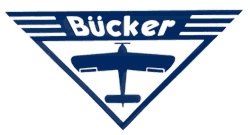

Bücker aircraft
Carl Clemens Bücker was a naval aviator
during the Great War; in 1921 founded in Sweden the Svenska Aero
Aktiebolaget, principally known by its fighter J.6 "Jaktfaik" which was
produced in short series for the aviation of the Scandinavian country.
Back to his natal Germany, in October 1933 he founds the Bücker-Flugzeubau,
whose first product is this graceful biplane designed by Anders J.
Andersson in collaboration with Bücker himself.
With interchangeable wooden twin-spar wings and the fuselage in steel
tube, it is all covered with cloth except for the engine's fairing and the
cabin sides that are covered with metallic sheet. Logically, it has got
double control and the landing gear is provided with oleoelastic shock
absorbers and brakes.
From the first flights accomplished by Joachim Von Kóppen, the success is
categorical, beginning with the first deliveries at the end of the same
1934. There is such a big demand that it is necessary to build a new
factory and if so the production figures are unknown in Germany, they have
to be counted by thousands. They export to many countries and it is built
under license in four of them; only in Japan 1.254 of them are delivered.
Light and robust at the same time, it is easy to keep and repair and for
the pilot it is really nice to fly. Capable of manoeuvring and its
controls admirably coordinated, it is not, however, as easy to fly as it
seems - it requires a pilot awake at all times. It will never play tricks
on him; it is a perfect school airplane. On Second World War, besides
being a Luftwaffe standard trainer and most of the allies performed a
service of nightly harassment on the Russian front, armed with
antipersonnel bombs.
With the arrival at Spain of the first official forces of the Condor
Legion November 6th 1936, the first three Bü-I 31 get to Spain too, from
the sixty that should be received in total, some provided with the Hirth
engine of 80 HP and most of them with the 105 HP. They are initially
destined to the elemental school of El Copero (Seville) and afterwards to
other new centres.
Right in the post-war period CASA starts the manufacturing under license,
the first Spanish Bücker flying march 14th 1941. After building
two-hundred of them with German engines, the delivering of the ones
provided with the
Spanish "Tiger" starts in 1950, completing the orders in 1963 after the
building of three hundred of these last ones and transforming thirty more,
propelled before by the Hirth.
|
